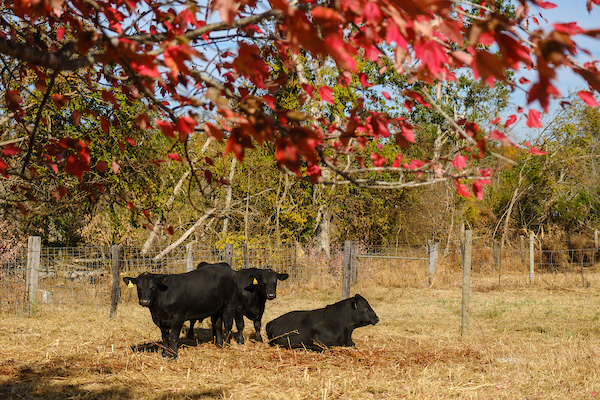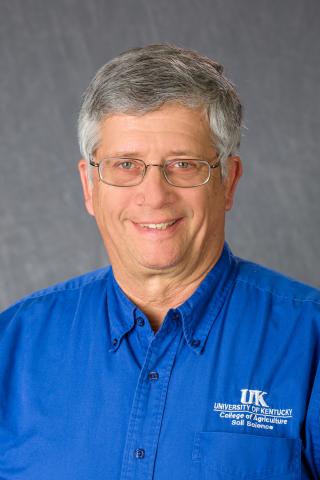9-History-2000s
A New Millennium and Change in Farming Focus (2000s)

Aerial photo of the 2005 Corn, Soybean and Tobacco Field Day
Kentucky agriculture, which had been dominated by tobacco production for several decades, began to shift its focus following the signing of the Master Settlement Agreement in 1998. UKREC played a significant role in this transition.
Forage Research
UKREC’s agronomy researchers studied grazing systems, breeding and evaluation of improved forage varieties, and harvest and storage systems for hay silage, and they also expanded into new areas including nutrient management and GIS technologies.
The center’s longstanding research into tall fescue toxicosis continued, as new toxicant-free endophytes were introduced into adapted cultivars. Forage storage systems were refined to improve quality and minimize losses, and comparative studies on forage intake and weight gain for cattle on hay and baled silage were conducted.
Agronomists also started to explore the use of new technologies and management practices, such as GPS, remote sensing technology and GIS, into existing grassland-based farming enterprises.
Beef Integrated Resource Management (IRM)
 As farmers in Western Kentucky began to lose revenue from tobacco in the 1990s and early 2000s, many considered raising cattle to fill the gap. The problem was that Kentucky’s cattle industry as it existed at the time was not profitable for producers.
As farmers in Western Kentucky began to lose revenue from tobacco in the 1990s and early 2000s, many considered raising cattle to fill the gap. The problem was that Kentucky’s cattle industry as it existed at the time was not profitable for producers.
In 2000, the Beef Integrated Resource Management (IRM) teams in Kentucky and Tennessee secured a joint USDA grant of $750,000 with the goal of increasing the income and profitability of beef operations in both states through an intensive educational effort. The project’s aim was to take the latest technology and information directly to the producers, showing them how to apply it and helping them to measure performance and ultimately making them industry leaders in their local area.
The effort launched a host of comprehensive educational programming, including the Master Cattleman Program and the Certified Preconditioned for Health (CPH-45) Program, that continue to enhance the knowledge of both new and experienced beef cattle producers throughout the region.
Beef Bash
UKREC launched its first annual Beef Bash event in 2010, a hands-on field day for Kentucky beef cattle producers of all experience levels. The event, held with the support of the Kentucky Cattleman’s Association, provides the most current information available on beef cattle production every year and offers an opportunity to highlight the UKREC beef unit’s work as a critical component of UK’s beef cattle extension and research programs.
Ethanol and Distillers Grains Feeding Trials
Increased production of ethanol in Kentucky with the installation of Commonwealth Agri-Energy in Hopkinsville, grew the availability of distillers grains for livestock. From 2008 to 2012, UK researchers conducted studies on feeding distillers’ grains derived from the production of spirits or ethanol to livestock and advised farmers on the opportunities they presented to develop more cost-effective diets for beef cattle.
Soil Sampling
Collecting a good representative soil sample is the first step in assessing a farmer’s fertilizer needs. A sample that does not reflect actual soil conditions can lead to misleading results and costly over- or under-fertilization.
As no-till farming became more popular in western Kentucky, researchers at UKREC determined that the common practice of sampling to the depth of a conventional tilling operation (typically six to eight inches) didn’t provide an accurate picture for soils that were not being turned regularly. Based on the results of their studies, soil sampling depth recommendations for non- or reduced-tilled areas were changed to three to four inches for pastures and one to two inches for no-till and minimum-till plantings. The change helped no-till farmers to be better informed in their decisions on fertilizer applications, improving their productivity while also preserving the health of the soil and the environment.
Variable Rate Technology
Research introduced Kentucky farmers to variable rate technology (VRT), specifically for the application of fertilizers and pesticides. The research quantified the economic and environmental benefits for Kentucky farmers. UK soil physicist Ole Wendroth and Princeton farmer Trevor Gilkey have partnered on some of the Princeton center’s most significant research projects related to variable rate nitrogen and irrigation systems on Gilkey’s Hillview Farms over the years.
Fragipan Remediation
UK soil scientists conducted laboratory, greenhouse and field experiments throughout the 2010s to gain a better understanding of the fragipan, a naturally occurring restrictive soil horizon that can restrict water movement and root growth just a few feet below the soil on many Kentucky farms. The fragipan is present in roughly 2.7 million acres of Kentucky soil, primarily in the western half of the state, and in roughly 50 million acres across the United States. Finding ways to break it down had proven to be a challenge for farmers and researchers alike, until UKREC research showed that planting annual ryegrass degraded the fragipan and increased yields more effectively than any other chemical or plant alternative. Lab results showed that the annual ryegrass produced chemicals that dissolved specific cementing agents in the fragipan and turned portions of it back into productive soil particles. Trials also indicated that the degradation process was cumulative over multiple seasons. The research breakthrough offered new prospects for potential long-term improvements to those interested in cracking through the restrictive fragipan on their farming operations.
Alternative Crops
Research by Edwin Ritchey and Greg Schwab into the viability of alternative crops, such as canola, sunflowers, and grain sorghum, sought to provide Kentucky farmers with viable alternatives to traditional crops like tobacco. The introduction of alternative crops gave farmers options for possible new revenue streams and reduced their dependence on tobacco, helping to bolster the region’s economic stability.
Tobacco
In the early 2000s, some of UKREC’s most influential tobacco research was focused on helping farmers to reduce the presence of harmful compounds in tobacco, specifically nitrosamines, to meet changing industry expectations. The research showed that heavy use of increasingly expensive nitrogen contributed to higher nitrosamine levels without improving yields or quality.
In the late 2000s, an alternative conservation tillage system emerged, in which narrow strips were cultivated for planting while the rest of the field was left undisturbed. Todd Harton, a tobacco grower in Trigg County, was one of the first to implement the method for tobacco, which was known as strip tillage. Roughly two-thirds of growers in Western Kentucky would come to use strip tillage in their own operations, with an additional 10 to 15 percent engaging in no-till tobacco farming.
From 2005 to 2015, more tobacco research at UKREC investigated harm mitigation opportunities related to the crop’s curing process. Fire-curing dark tobacco in Western Kentucky involves a four- to five-week smoldering process, using hardwood slabs and sawdust to impart a unique and world-renowned character to the leaf. The research results showed that adjusting the timing of the first firing, reducing the duration of firing, and maintaining barn temperatures at no higher than 130 degrees Fahrenheit helped to reduce the levels of both nitrosamine and an additional carcinogen related to the fire-curing process, benzopyrene.
Farm Energy Audits
UKREC-based ag engineers Sam McNeill, Michael Montross, and Doug Overhults undertook on-farm energy audits for farmers and rural small-business owners across Kentucky. The assessments included potential projects such as production barns for dairy and poultry farms, grain drying or handling systems, solar PV installations, and irrigation pumping stations.
Packing Factors for Whole Grains and Feed
University of Kentucky ag engineers Sam McNeill, Aaron Turner, and Michael Montross teamed up with researchers from the University of Georgia, Kansas State, and the USDA Agricultural Research Service to address the need for reliable grain pack factors to apply in a science-based model (WPACKING) to estimate storage capacities and monitor grain inventories accurately. Stored grains compact under their own weight, and changes in bulk density and volume can differ based on factors such as grain type, moisture content, bin geometry, and bin material. Measuring the field pack factors and bin capacities on farms and comparing those to the model predictions was essential in the development of an accurate modeling system for grain storage across the country.
As U.S. farmers were producing record yields for corn and soybeans in 2015, UKREC extension staff advised farmers on the best storage practices for minimizing grain spoilage, including the construction of storage structures, proper aeration, and rodent, bird and insect control.
Hemp Research Initiative
With the legalization of industrial hemp in Kentucky, UKREC launched the Hemp Research Initiative to explore the potential of hemp as a viable crop and a new economic opportunity for Kentucky farmers. The research has explored topics including cultivation methods, pest management and market potential for the alternative crop and helped to establish best practices for hemp cultivation.
Double-Cropped Soybeans
Since the early 2000s, double-cropped soybeans have accounted for roughly one-quarter of all soybean production in the state. Continuing research into double-crop soybean production at UKREC has helped farmers to consider new varieties and refine management strategies to increase yield potential and profitability. The work at Princeton has yielded research-based guidance in areas including optimal planting dates, variety selection, and seeding rates. For example, UKREC studies have demonstrated that the planting date can have a significant impact on profitability for double-crop soybean production, with yield decreases of roughly 0.9 percent for each day that double-cropped soybean planting is delayed.
Station Milestones
 2009
2009
Professor and soil scientist Lloyd Murdock is named director of the UK Research and Education Center following Donnie Davis’ move to Lexington. Murdock devoted half his time to leading the center while also continuing his extension work in soils and his service as a professor in UK’s Department of Plant and Soil Sciences.
 2012
2012
Richard Coffey, a longtime leader of Kentucky youth livestock programs and swine extension, was named director.
2015
 John Grove became director of the UK Research and Education Center. Grove, a soil scientist, had served on the UK faculty since 1981, and he had conducted research at the farm in Princeton dating back to 1986.
John Grove became director of the UK Research and Education Center. Grove, a soil scientist, had served on the UK faculty since 1981, and he had conducted research at the farm in Princeton dating back to 1986.
2020
 Dr. Carrie Knott, extension agronomist at UKREC since 2013, was appointed as director of the UK Research and Education Center in Princeton.
Dr. Carrie Knott, extension agronomist at UKREC since 2013, was appointed as director of the UK Research and Education Center in Princeton.
